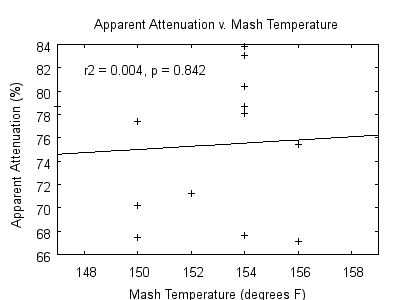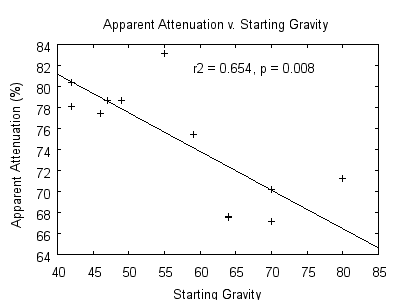Brewery Research
Introduction
In a former life I was a Ph.D. candidate in Botany, and learned a lot about statistical analysis along the way. I've since been applying some of these techniques to my brewing to better understand what goes on during the process. My current focus has been on determining the variables important in predicting attenuation.
Design
My analysis considers all the batches I've brewed since my setup stabilized, which at the moment includes 13 batches. For each batch, I'm estimating (or measuring): mash temperature, color, starting gravity, yeast variety, and attenuation. Mash temperature is commonly understood to be negatively correlated with attenuation within the approximate range of 140°F - 160°F, and variety of yeast is also thought to be important.
Data are analyzed using the R statistical package. R is similar to the S language, which is what the commercial statistical package S-PLUS is based on. R is freely available for most computing platforms, and is in continual development. For the analysis that follows, the lm and anova functions were used.
Results
The most commonly understood variable for predicting attenuation is mash temperature, and most brewers use lower mash temperatures (148°F is common) to produce a more highly attenuated beer. Higher mash temperatures (154 - 156°F) are thought to yield maltier, less attenuated results.
My results so far do not show this pattern. The right (or upper) graph below, shows the actual data (crosses) and a linear fit. None of the coefficients are significantly different from zero, and almost none of the variation in attenuation can be explained using mash temperature.


The graph on the left (or the lower graph) shows a similar analysis for starting gravity. In this case, I can explain more than half the variation in attenuation with starting gravity. For my data, higher starting gravities result in lower apparent attenuation.
Yeast strain is also important, and yeast labs publish attenuation ranges for the strains they sell. Considering yeast strain alone won't yield useful results because we have already shown that starting gravity has a significant (and great) effect on attenuation by itself. Unfortunately, no model with these variables included was significant.
Discussion
It seems strange that for these thirteen batches, the two things most brewers consider to be most important for predicting attenuation weren't significant in my analysis. There are several possible reasons for this.
First is my "experimental design". There wasn't any. I'm more interested in brewing good beer than studying the variables involved, and as a result, the power of my analysis suffers. This is especially true for yeast strain. I've used one strain of yeast (White Labs 023, Burton Ale) five times, two strains (WLP001 and Wyeast 1056 -- although they may actually be the same strain) twice, and four other strains only once. For a proper analysis of variance, each strain should have been used over a range of temperatures and specific gravities in order to tease out just the effect of yeast on attenuation. The same problem is true of specific gravity and temperature, although to a lesser extent.
In time, with additional batches entering the analysis, there's a good chance that this will become less important simply because I will have data for more combinations of the measured variables. There are a limited number of yeasts I use, so the cells in the anova table may start to become better balanced.
Second, it's always possible in any analysis that there's some other factor that's more important than any of the variables under consideration. For example, if the thermometer I'm using to measure mash temperature is off by 10 degrees of more, I may be mashing all of my beers outside the range where the two primary saccarification enzymes operate. Mash thickness, percentage of adjuncts, grain types are all variables that may affect attenuation (or affect the variables I am examining), but are not considered in the analysis.
Population size and health of the yeast, as well as fermentation temperature are also commonly discussed when there are problems with attenuation in a batch. I don't have a good method for measuring these parameters, but my yeast starter technique and my fermentation temperature regulation have remained fairly consistant over the course of the batches analyzed here. But if there's a significant amount of variation in these variables (despite my attempts to reduce it), the true effects of yeast strain and mash temperature may be hidden by this variation. If this is the case, more data should improve the power of my analysis to identify yeast strain and mash temperature despite this possible source of error.
Conclusions
More than half of the variation in attenuation I've seen can be explained by the starting gravity of the wort. The higher the gravity, the lower the attenuation. This is a useful thing to know, especially since it's not one of the factors people discuss when considering how to control attenuation. If I've got a high gravity wort whose style requires higher attenuation than my results predict (like an IPA, or Belgian beer), I may need to think more seriously about lowering the mash temperature or using a yeast strain that is purported to ferment to a lower final gravity or tolerate higher alcohol. I can't show that this will help, but my analysis does identify cases where I may have problems if the attenuation I'm shooting for is outside what I'd predict based on starting gravity.
Also, if you have data you'd like analyzed, or would like to share with me, I'd appreciate it. You can never have too much data!
Other Brewing pages:
| Recipe List | Equipment | Books |